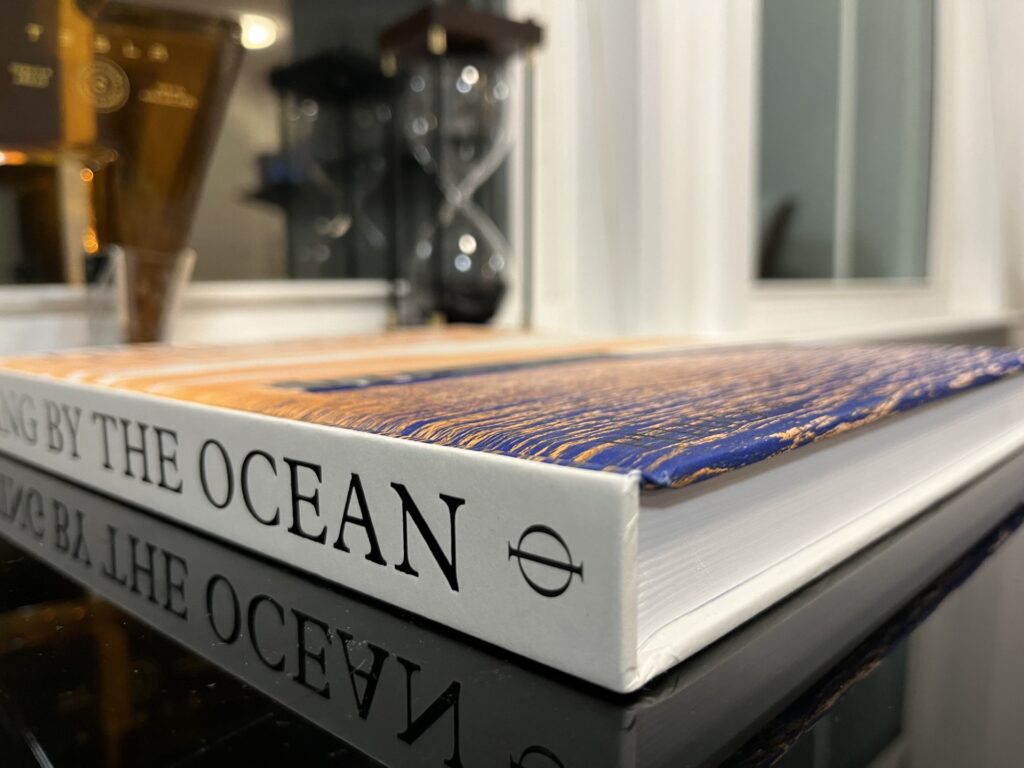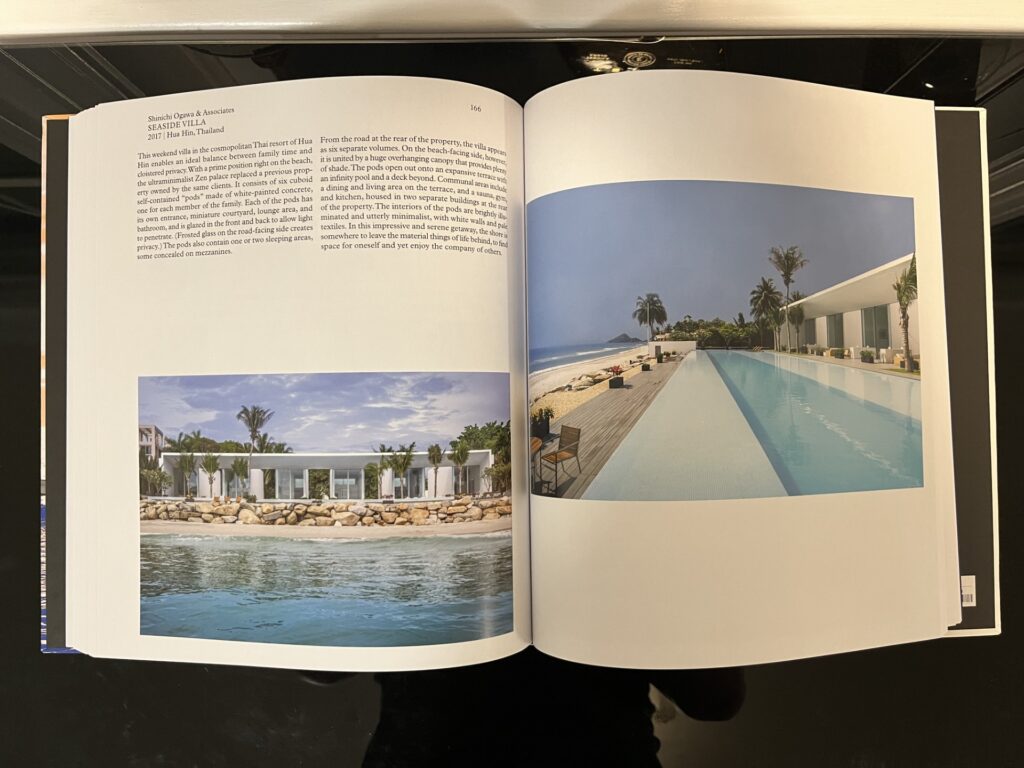For anyone captivated by coastal living, “Living by the Ocean: Contemporary Houses by the Sea” offers a stunning glimpse into remarkable homes along breathtaking shorelines. This coffee table book showcases architect-designed residences that blend seamlessly with their ocean surroundings. It reveals how these homes not only celebrate their locations but also harmonize with the powerful beauty of the sea.
Each page invites readers to explore diverse styles, from modern to classic, all set against picturesque backdrops of beaches and cliffs. The book is filled with vibrant photographs that transport you to these serene spaces. It serves as inspiration for anyone dreaming of a life by the water or seeking decorating ideas that reflect coastal charm.

Whether you’re an architecture enthusiast or simply appreciate beautiful design, this collection has something to offer. The stories behind these homes add depth and context, making it more than just a showcase of stunning visuals. This book is a delightful addition to any coffee table, sparking conversations and wanderlust alike.
The Allure of Coastal Living
Coastal living attracts many people with its unique benefits and rich history. The fresh air, stunning views, and relaxed lifestyle create a special appeal that is hard to resist. Residents enjoy not just a beautiful environment, but also a deeper connection to culture and tradition.
Health and Lifestyle Benefits
Living by the ocean offers numerous health benefits. Fresh sea air can improve lung function and boost mood. The sound of waves crashing creates a calming atmosphere, reducing stress levels significantly.
Coastal areas often promote outdoor activities like surfing, swimming, and hiking. These activities encourage a more active lifestyle. Studies show that people who live near the coast are generally more physically active.
Access to fresh seafood is another plus. Eating fish has many health benefits, including heart health and improved brain function. The combination of outdoor living and healthy eating leads to an overall better quality of life.
Cultural and Historical Significance
Coastal regions are rich in cultural and historical significance. Many coastal communities have unique traditions stemming from their maritime heritage. This can include local festivals, arts, and crafts that celebrate their connection to the sea.
The architecture of coastal homes often reflects historical styles and local materials. This adds to the charm and character of these areas. People who live in these communities often take pride in preserving their history.
Visiting coastal towns allows individuals to experience a blend of cultures. From fishing villages to bustling seaside cities, each place has its own story. This cultural diversity enhances the allure of coastal living, making it enriching both personally and socially.
Design Elements of Coastal Homes

Coastal homes blend style and functionality. They take inspiration from the surrounding environment, using materials and designs that reflect the beauty of the ocean.
Architectural Features
Coastal homes often feature large windows that let in natural light and offer stunning views of the sea. These windows can be floor-to-ceiling, creating an open and airy feeling inside.
Many also have porches or decks that extend living spaces outdoors. This encourages relaxation and social gatherings, making the most of coastal breezes.
Materials such as wood, stone, and metal are common. They can be used to create a rustic or modern look, depending on the homeowner’s taste. This combination provides durability against salty air and harsh weather.
Interior Design Themes
Inside these homes, the design often embraces a relaxed, beachy vibe. Colors are typically light and airy, like whites, blues, and sandy beiges. This palette creates a calm atmosphere reminiscent of the beach.
Furnishings might include wicker and driftwood elements. Soft fabrics and plush cushions are used to enhance comfort. Nautical decor like ship models or ocean-themed artwork can be found throughout, bringing in the seaside charm.
Open floor plans are popular, allowing free movement and connection between spaces. This setup promotes interaction, perfect for family gatherings or entertaining guests.
Landscape Integration
Coastal homes are designed to blend seamlessly with their surroundings. Native plants are often chosen for landscaping. They require less water and maintenance, making them practical and eco-friendly.
Hardscapes like stone pathways or wooden decks connect indoor and outdoor spaces. This encourages outdoor living and enhances the view.
Sometimes, houses are elevated on stilts to protect against floods. This design also allows for better views of the ocean and helps to keep homes safe from harsh weather.
Showcasing the Homes
The homes in “Living by the Ocean: Contemporary Houses by the Sea” are celebrated not only for their stunning designs but also for the environment they inhabit. Each featured residence tells a unique story, highlighted by striking photography and thoughtful presentations.
Photography and Presentation
The book’s photography captures the breathtaking beauty of each home. High-quality images showcase how these houses blend with their coastal surroundings. Each picture emphasizes architectural details, textures, and the vibrant colors of the landscape.
The layout is designed to draw the eye, with several images per house allowing readers to appreciate different angles. This visual storytelling helps convey the essence of oceanfront living. Readers will find themselves immersed in the scene, imagining the sights and sounds of the ocean.
Stories Behind the Homes
Every home has a fascinating story, reflecting the dreams and aspirations of its owners and architects. The book shares insights about the inspiration behind the designs and the challenges faced during construction.
Readers learn how local culture, climate, and topography influence these homes. From eco-conscious choices to unique architectural features, each house showcases the creative process. The blend of nature and design tells a compelling narrative about life by the sea.
Sustainability and Innovation
The focus on sustainability and innovation in contemporary coastal homes highlights efforts to blend beautiful design with environmental responsibility. Many of these residences demonstrate a commitment to eco-friendly practices and the use of cutting-edge materials, ensuring they respect their breathtaking surroundings.
Eco-Friendly Practices
Many homes featured in Living by the Ocean prioritize sustainability through eco-friendly practices. These include incorporating solar panels, rainwater harvesting systems, and energy-efficient appliances.
Designs often aim to minimize energy consumption and reduce the carbon footprint. For example, some houses use natural ventilation techniques to reduce reliance on air conditioning.
These approaches not only help the environment but also result in lower utility bills for homeowners. The combination of visual appeal and eco-consciousness makes these properties stand out.
Cutting-Edge Materials
The use of cutting-edge materials plays a significant role in modern coastal home design. Homeowners increasingly choose sustainable materials such as bamboo, reclaimed wood, and recycled metal.
These materials are not only environmentally friendly but also durable and attractive. For instance, bamboo grows quickly and regenerates easily, making it a popular choice for flooring and furniture.
Additionally, advancements in weather-resistant materials help homes withstand harsh coastal conditions. These innovations lead to structures that are both beautiful and built to last.
Impact of Climate Change
Climate change significantly affects coastal homes and their surrounding environments. Rising temperatures, increased storm intensity, and shifting coastlines pose challenges that require thoughtful solutions for homeowners by the sea.
Adaptation and Resilience
Homeowners are adapting to climate change by making their properties more resilient. This includes using materials that can withstand extreme weather conditions and raising structures to reduce flood risks. Buildings may now incorporate features like elevated foundations and storm-resistant windows.
Additionally, environmentally friendly practices are becoming popular. Homeowners might use solar panels and rainwater harvesting systems. These adaptations not only help in managing climate impacts but also promote sustainability.
Landscape design is crucial too. Native plants can be integrated into gardens to reduce erosion and support local wildlife. This practice enhances both the beauty and health of coastal environments.
Coastal Preservation Measures
Coastal preservation is essential for protecting homes from the impacts of climate change. Strategies include creating buffer zones with vegetation and restoring wetlands. These natural barriers can absorb storm surges and reduce flooding risks.
Community engagement plays a vital role in preservation efforts. Local governments and organizations often encourage residents to join conservation projects. These initiatives help maintain the local ecosystem, which is crucial for both health and aesthetic value.
Regulations also guide development in coastal areas. Zoning laws may restrict building near vulnerable coastlines, which can help safeguard homes from erosion and flooding. Through these measures, communities work together to protect their coastal environments while celebrating their beauty.
Architect Profiles
This section focuses on the talented architects featured in “Living by the Ocean: Contemporary Houses by the Sea.” Their innovative designs and approaches highlight how architecture can harmonize with coastal environments.
Leading Coastal Architects
Several prominent architects are known for their exceptional work on coastal homes. They bring unique styles and visions to each project, ensuring that each residence is both beautiful and functional.
Richard Meier: Known for his clean lines and modern aesthetic, Meier often incorporates natural light and stunning ocean views into his designs.
Norman Foster: This architect emphasizes sustainability, blending ecological considerations with modern design.
Renzo Piano: Piano designs structures that respond to their environment, focusing on blending architecture with nature.
These architects lead the field in creating spaces that inspire and connect with their coastal surroundings.
Innovative Design Philosophies
Architects of coastal homes often adopt innovative design philosophies. They aim to create spaces that are not only visually striking but also environmentally friendly.
Sustainable Materials: Many architects use recycled or locally sourced materials to lessen environmental impact.
Maximizing Views: Design principles focus on orienting homes to capitalize on ocean views, often utilizing large windows and open spaces.
Natural Ventilation: Incorporating ventilation strategies ensures energy efficiency, allowing homes to stay cool without heavy reliance on air conditioning.
Reader Engagement
This book engages readers through unique interactive elements and insights from the author. These features create a deeper connection to the stunning homes and coastal settings.
Interactive Elements
“Living by the Ocean” includes various interactive features that enhance the reader’s experience. Each section may prompt readers to reflect on their own coastal dreams or share personal stories related to the ocean.
For example, some pages might include QR codes that link to virtual tours of the featured homes. Readers can explore these magnificent spaces further through multimedia content, making the experience more immersive.
Additionally, the book may encourage readers to sketch their favorite coastal designs or write down their thoughts in the margins. These elements invite readers to not only view stunning images but to actively engage with the content, bringing their own creativity into the mix.
Thoughts from the Author
The author shares personal reflections throughout “Living by the Ocean.” These insights provide context and background for the featured houses, revealing what inspired their design and location.
Readers learn about the stories behind the architects and homeowners, creating a connection to each residence. The author’s passion for coastal living shines through, making it easy for readers to relate to the beauty and tranquility of these homes.
With each thought shared, the author hopes to inspire readers to appreciate the relationship between architecture and nature. These reflections make the book more than just a collection of stunning images; they transform it into a celebration of ocean-inspired living.
